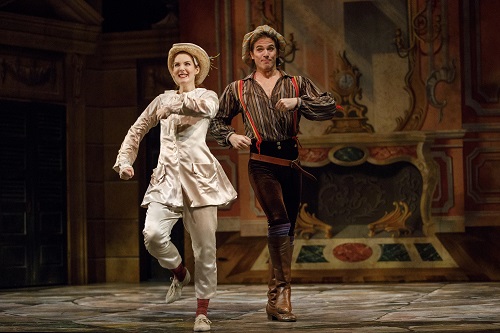 Opera Atelier takes on The Marriage of Figaro on the Toronto stage
Opera Atelier takes on The Marriage of Figaro on the Toronto stage
Le nozze di Figaro is one of the most known works in the operatic canon. Opera Atelier’s 2017 remount of their Dora award-winning production made me realize that while everyone knows of Figaro, I will never truly “know” Figaro.
The Marriage of Figaro is based on a pre-revolutionary French play that was a radical and sharp critique of society’s upper crust. The play’s alternate title translates to “The Mad Day” and it certainly is that.
Count Almaviva (Stephen Hegedus) has already grown bored with the lovely Rosina (Peggy Kriha Dye), who he pursued so fervently only three years earlier in this story’s prequel, The Barber of Seville. The Count has set his sights on lovely young Susanna (Mireille Asselin), who is maid to Countess Rosina, and betrothed to Figaro (Douglas Williams). Figaro, meanwhile, had been working as a barber in Seville prior to being granted a high-profile position as the Count’s major-domo as a reward for helping to arrange his marriage to the beautiful Rosina. Now Figaro, Susanna, and the Countess must get cunning and whimsical to fend of the Count’s advances and teach him a lesson about the ills of his lechery. Wackiness ensues.
And there ends my comprehension of Figaro. I have seen and been in a number of Figaro scene studies, and even wrote a grad school paper on this work. I just do not get it. The far-fetched, convoluted storylines of other Mozart masterpieces such as Cosi fan tutte, The Magic Flute, and The Abduction from the Seraglio do not phase me. In this opera, I was afflicted by a condition I have now dubbed “hysterical boredom” halfway through Act II, and I knew I was in for a long evening.
As mentioned above, this production has won a Dora award, so I realize my opinion goes against the grain. The most compelling innovation of this production is that it is mounted in English using a modern translation. This choice makes the work much more approachable for today’s audiences. It also better serves the comedy, since viewers get to experience the punchlines in real time. Surtitles are usually out of sync with the action on stage, and end up stepping on the comedic timing.
The music is also Mozart at his most capricious and elegant. Every aria, duet and ensemble from this work is a hit. This production featured superb performances from Atelier favourites and newcomers alike.
Douglas Williams was delightful in his Atelier debut in the title role. His voice is crisp, confident, carefree and nimble, just like his character. His performance of “Se vuol ballare” and the reprises of the line “You may go dancing, but I’ll call the tune” was playful and smooth, with effortless litheness through the aria’s twists and curves.
Atelier regular Mireille Asselin was charming and sassy in the role of Susanna. The opera contains some “humour” about sexual coercion that is difficult to play for laughs in 2017. Asselin kept her wits and her dramatic chops about her to preserve the upper hand in those scenes. Her performance of “Deh vieni non tardar” (Come, don’t delay), the aria that every pre-professional soubrette soprano dreams of singing on the major stage, was grace and sensuality personified.
Asselin’s duet “Sull’aria” with Peggy Kriha Dye as the Countess was also a highlight. While the objective of the ruse underpinning this duet is still elusive to me, it is one of the most stunning examples of Mozart’s deceptively simple compositional genius. Kriha Dye’s rich, yet luminescent soprano voice is well known to Atelier audiences and ideal for the role of the noble, beautiful and lonely countess. She makes a memorable and moving entrance at the start of the second act with a sensitive performance of another hit aria from this work, “Porgi, Amor”.
Mireille Lebel gave a spirited and endearing performance as Cherubino, the young page whose hormones are running wild. Lebel used her warm, ruby tone and agility to full effect in her performance of the whirlwind “Non so piu cosa son, cosa faccio” and languid “Voi, che sapete”, two more hits from this opera.
The orchestra pulled out all the stops with its performance of the overture, which is, in its own right, one of the most recognizable pieces from this work.
All in all, while this production was certainly of the superb quality I expect from an Atelier, it somehow lacked Atelier’s usual flare. Splashy and vibrant use of colour is one of my favourite features of Atelier’s usual offerings, but this production worked with a rich colour palette of earth tones and deep reds that for me felt incongruous with the frothy nonsense that is Figaro. There aren’t many opportunities for dancing here, and when dancing was incorporated, I felt the choreography lacked its usual pizazz.
There is no way to be disappointed by the music from this opera, and if Atelier decided to produce a recording of this production, I would be the first person to pre-order it. It fell flat for me dramatically, but it was clear from the hearty laughter heard throughout that many audience members did not share my view. This production is an excellent opportunity for Mozart aficionados and genre newcomers to see this iconic masterpiece.
Details:
- The Marriage of Figaro is playing until November 4, 2017 at The Elgin and Winter Garden Theatre (189 Yonge Street)
- Show times are 7:30 PM on October 31 and November 3; with additional matinees at 3 PM on October 29 and 4:30 PM on November 4.
- Ticket prices range from $45 – $189. Patrons under 30 can purchase tickets from $24.
- Tickets are available online, or through the box office at 416-314-2884
Photo of Mireille Lebel and Douglass Williams by Bruce Zinger
